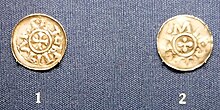Coin Cabinet (Dresden)


The Münzkabinett in Dresden is a collection of historical coins , banknotes , medals , securities , orders and decorations , seals and seal impressions , stamps of the Saxon State Mint Dresden and hollow huts and mint-technical devices that originated in the early 16th century. This makes it one of the oldest German coin collections and with around 300,000 individual pieces after the Berlin and Munich collections, it is the most extensive of its kind in Germany and one of the largest and most important coin cabinets in Europe.
The numismatic museum belongs to the Staatliche Kunstsammlungen Dresden and is located in the Dresden Residenzschloss .
history
The collection goes back to George the Bearded . The Duke's book of editions mentions the German medalist Hans Schwarz as the designer of several medals in the collection.
Elector August expanded the collection by employing important medalists such as Valentin Maler from Nuremberg and Tobias Wolff from Breslau and by purchasing lead casts of missing originals. Johann Georg II of Saxony had the coin collection outsourced from the Electoral Art Chamber and reorganized.
With the passion for collecting coins that arose among the electors in the 18th century, the collection was significantly expanded. August the Strong is closely related to this . In 1716 he acquired the collection of General von Birckholtz and in 1718 a collection of ancient coins from the estate of Duke Moritz Wilhelm von Sachsen-Zeitz .
After 1743 the collection was housed in the Taschenbergpalais . In 1786, under Elector Friedrich August III. of Saxony (from 1806 King Friedrich August I of Saxony) , it was set up together with the electoral library and the collection of antiquities in the Japanese Palace , the newly rebuilt "Museum Saxonicum". Several large private collections came into the coin cabinet under King Friedrich August I of Saxony. These included the Groschenkabinett of Hofrat David Samuel von Madai with around 9,000 coins and the gold coin collection of the Abbé and court chaplain Joseph Gotthard Baumgarten (1737-1816). During this time, collecting activities increasingly focused on medieval and Saxon coins.
In 1831 the coin cabinet came under state administration, which enabled further purchases with higher financial resources. In 1858 the ancient coins could be acquired from the estate of Prof. Moritz Steinla . In the 1870s, the medieval collection with 29,000 individual items and the library, consisting of 1,400 volumes from the estate of the manor owner Rudolf Benno von Römer (1803–1871), were added.
In 1877 the coin cabinet moved to the residential palace. Between 1911 and 1954 it was set up in the office building on the stable yard . The largest purchase during this period was the Geinitz small coin collection in 1916 with 39,000 individual pieces.
In World War II, nothing has been lost from the collection, but the office building was - the same issue - by the air raids on Dresden in February 1945 completely destroyed. After the end of the war, the collection was brought to the Soviet Union . In 1958 and 1959, Dresden received the collection back, but without the associated books and magazines. The exhibition took place in the Albertinum because the residential palace and the chancellery building had been completely destroyed in the war. Due to the art collections housed there, the space was very limited, so that only a selection of the collectibles could be shown.
With the reconstruction of the residential palace, the collection is present again there; However, until the premises intended for the Münzkabinett were completed in 2015, their exhibition could only take place to a limited extent. Since June 2015, after 11 years of construction, the Münzkabinett in the palace has again had permanent exhibition space and its own library with a study room.
exhibition
Around 3,300 exhibits, which represent the history of money from antiquity to the present, are shown in the former princely living quarters in the Georgenbau of the residential palace . In addition, visitors can delve into the world of coin, currency and art history in a special library comprising 30,000 titles or work in the study room.
The exhibition is divided into four areas (rooms):
- “Mining and Coin Minting in Saxony” gives an overview of 900 years of coin history in the Meissnian-Saxon area .
- “The Cosmos of Money” deals with the development of the monetary system from antiquity to the present.
- “All about money” looks at the topic of money in different aspects.
- “Medals and Orders” shows the development of medal art from the Renaissance to the present.
The oldest object in the museum is an electron coin from Lydia , more than 2500 years old , which was minted under King Alyattes II .
Web links
Individual evidence
- ↑ Christian Ruf: Reopening of the Dresden Coin Cabinet: Treasure Chest of Numismatics. In: Dresdner Latest News , June 6, 2015.
- ↑ Christian Ruf: The coin cabinet is back in the Dresden Palace. In: Dresdner Latest News , No. 120, May 27, 2015, p. 9.
Coordinates: 51 ° 3 ′ 9.9 ″ N , 13 ° 44 ′ 12.9 ″ E
